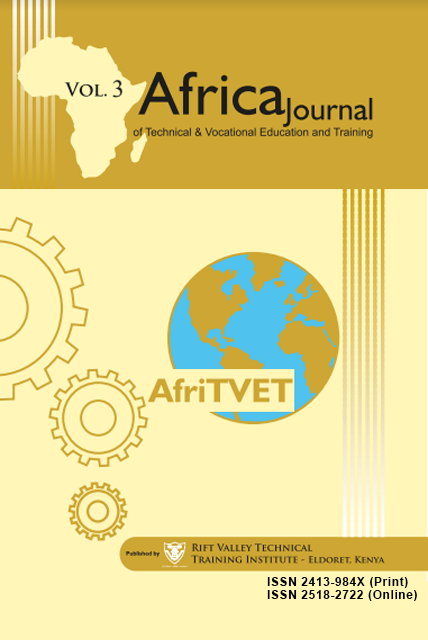Effect of Seed Coat Colour on the Seed Quality of Water Melon (Citrullus Lanatus)
Keywords:
Water melon, Seed Quality, Seed Colour
Abstract
Water melon is one of most cultivated vegetable fruit crop in the world. In Kenya the demand for this fruit for both local and export markets outstrips the supply. For Kenya to meet the high demand for water melon, quality seed is paramount since it guarantees high germination rate and vigor and on sequential high crop yields. However, it has been observed that water melon seeds have different seed coat colours even in the same growing season. The aim of this study was to establish to what extent seed colour affects seed viability (measured by % germination) and vigor (measured by absorption of water and electrical conductivity) of water melon (sugar baby variety). The study was conducted at University of Eldoret seed science laboratory. Seeds were obtained from the Kenya Genebank whose colour was determined using Munsell colour chart for plant tissues. Water absorption, electrical conductivity and germination percentage of seeds were determined using recommended methodologies. Complete random design was used and data collected was subjected to ANOVA and Duncan Multiple Range Test (DMRT) test at 5% level of significance using the GENSTAT version 14.2. The correlation between water absorption, germination and electrical conductivity was determined by Pearson Product moment correlation coefficient and regression analysis. It was found that water absorption, germination percentage and electrical conductivity significantly differed between the dark brown, light brown, brown and yellow seeds. Seed quality was highest for dark brown, followed by brown, light brown and finally yellow seeds. There was negative correlation between water absorbed and germination but positive correlation between water absorbed and electrical conductivity. It was concluded that seed companies should consider seed colour as one of the parameter during grading of water melon seeds. This would improve the quality of seed sold to farmers and consequently water melon yields in Kenya.Article Views and Downloands Counter
Download data is not yet available.
References
Baskin, J., Baskin, C., & Li, X. (2000). Taxonomy, anatomy and evolution of physical dormancy of seed. Plant Species Biology, 15. 139-152.
Bweley, J. D., & Black, M. (1994). Seeds: Physiology of development and germination. 2nd Edition. New York: Plenum Press
Demir, I., Mavi, T., & Duncan, G. (2004). Changes in germination and potential longevity of water melon seeds during development. Journal of New Zealand of Crop and Horticultural Science, 13 (4).43-8.
Desouza, F., & Marcos, J. ( 2001). Seed coat s a modulator of environment relationship in Fabacaea. Journal of Revista de Botanica, 4 (31). 88-97.
HCDA. (2006). Fruit and vegetable horticultural crop development authority. Technical Bulletin.
Issac, M., (2009). Nutritional value of vegetable fruit. Journal of Food and Nutrition of Africa.
ISTA. (2004). Seed science and technology. Zurich, Switerland: The International Seed Testing Association.
Itoh, P. (2008). Vegetable fruit overview. Journal of Horticultural Produce.
Mavi, K. (2010). Relationship between seed coat colour and seed quality in watermelon crimson sweet. Hort. Sci. Vol. 37, No. 2. 62–69.
Zhang, X. K., Yang, G. T., Chen, L., Yin, J. M., Tang, Z. L., & Li, J. N. (2006).
Physiological differences between yellow-seeded and black seeded rapeseed (Brassica napus L.) with different testa characteristics during artificial ageing. Seed Science and Technology, 34. 373–381.
Zhang, K., Wang, Z., & Chen, L. (2008). Imbibition behavior and flooding tolerance of grape seed with different testa colour. Genetic Resources Crop Evolution
55. 1175-84.
Bweley, J. D., & Black, M. (1994). Seeds: Physiology of development and germination. 2nd Edition. New York: Plenum Press
Demir, I., Mavi, T., & Duncan, G. (2004). Changes in germination and potential longevity of water melon seeds during development. Journal of New Zealand of Crop and Horticultural Science, 13 (4).43-8.
Desouza, F., & Marcos, J. ( 2001). Seed coat s a modulator of environment relationship in Fabacaea. Journal of Revista de Botanica, 4 (31). 88-97.
HCDA. (2006). Fruit and vegetable horticultural crop development authority. Technical Bulletin.
Issac, M., (2009). Nutritional value of vegetable fruit. Journal of Food and Nutrition of Africa.
ISTA. (2004). Seed science and technology. Zurich, Switerland: The International Seed Testing Association.
Itoh, P. (2008). Vegetable fruit overview. Journal of Horticultural Produce.
Mavi, K. (2010). Relationship between seed coat colour and seed quality in watermelon crimson sweet. Hort. Sci. Vol. 37, No. 2. 62–69.
Zhang, X. K., Yang, G. T., Chen, L., Yin, J. M., Tang, Z. L., & Li, J. N. (2006).
Physiological differences between yellow-seeded and black seeded rapeseed (Brassica napus L.) with different testa characteristics during artificial ageing. Seed Science and Technology, 34. 373–381.
Zhang, K., Wang, Z., & Chen, L. (2008). Imbibition behavior and flooding tolerance of grape seed with different testa colour. Genetic Resources Crop Evolution
55. 1175-84.
Published
2018-06-19
How to Cite
Maina, F., & S, N. (2018). Effect of Seed Coat Colour on the Seed Quality of Water Melon (Citrullus Lanatus). Africa Journal of Technical and Vocational Education and Training, 3(1), 195-201. Retrieved from https://afritvet.org/index.php/Afritvet/article/view/71
Section
CROSS CUTTING THEMES: SCIENCE & ENGINEERING
Copyright Notice
Copyright of published articles is held by AfriTVET. No limitation will be placed on the personal freedom of authors to copy or to use in subsequent work, material contained in their papers. Please contact the Publisher for clarification if you are unsure of the use of copyright material. Apart from fair dealing for the purposes of research and private study, or criticism and or review, this publication may only be reproduced, stored or transmitted, in any form or by any means, with the prior permission in writing of the Publishers.



